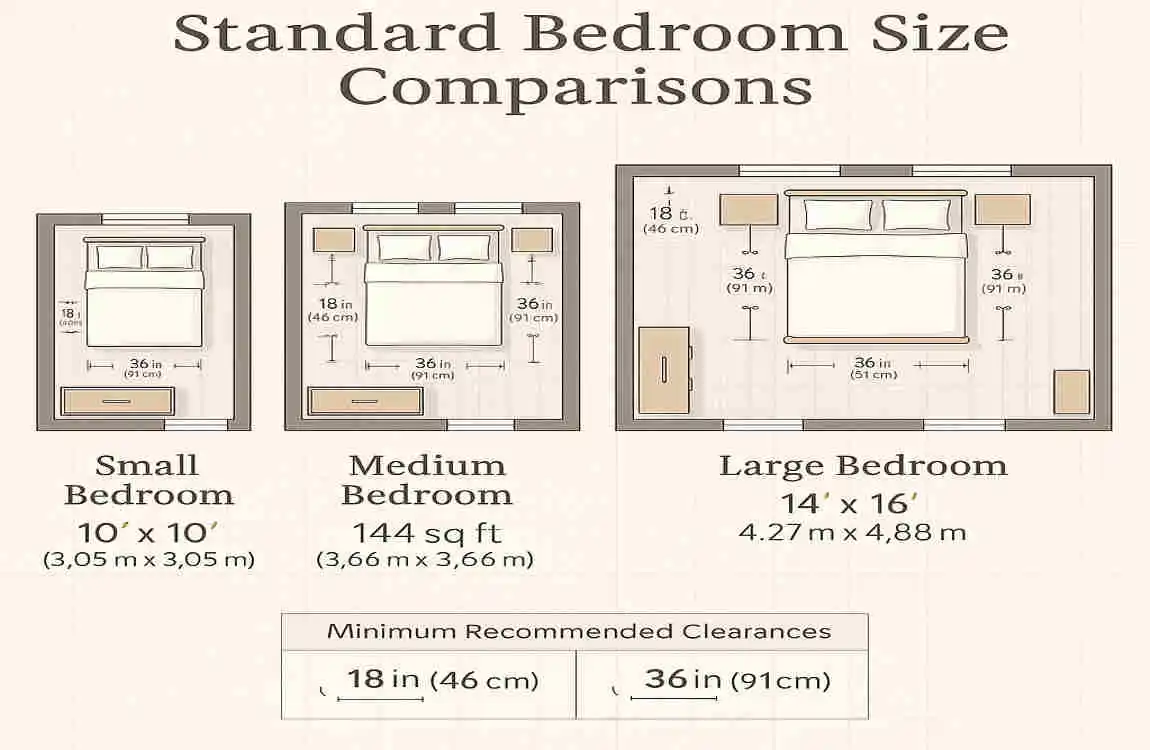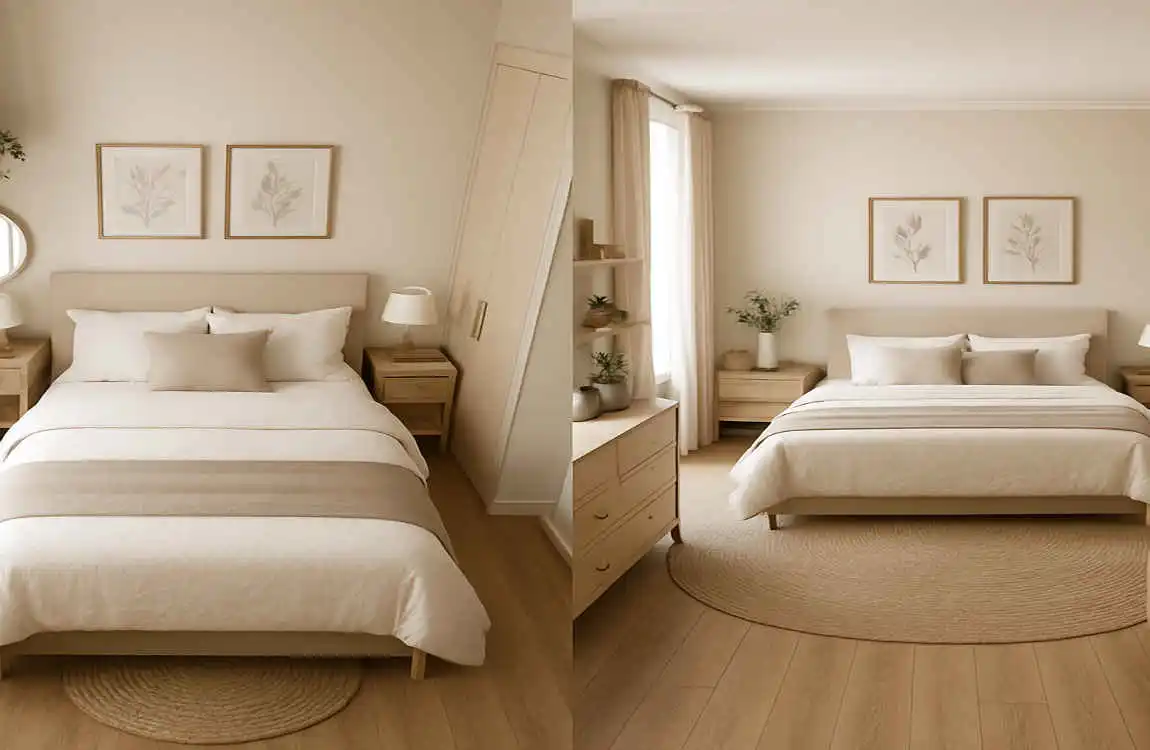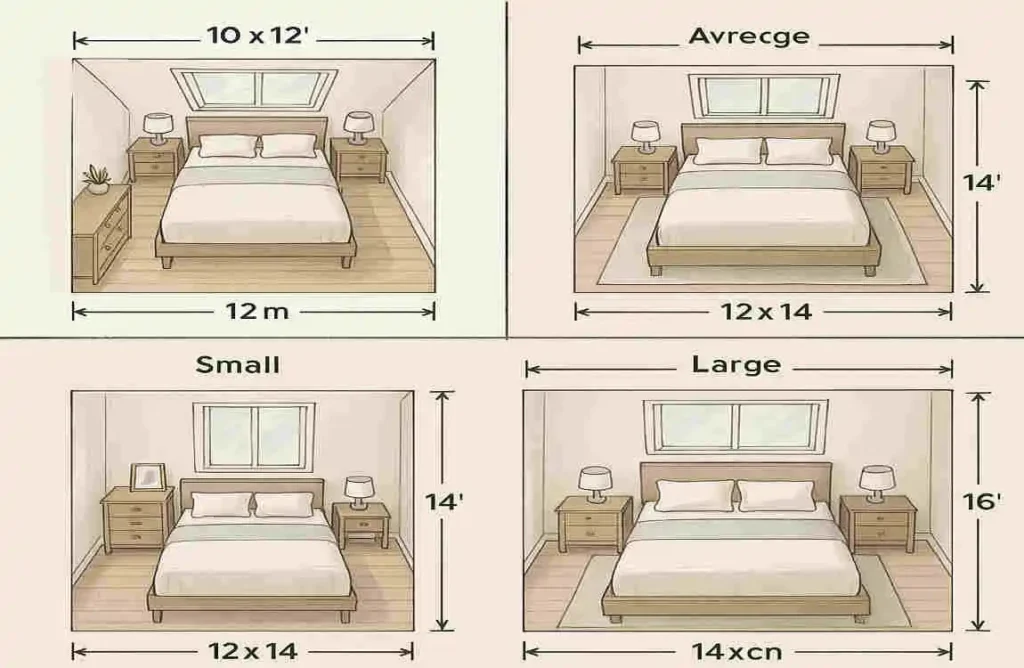When it comes to designing and decorating our homes, the bedroom often takes center stage. It’s our personal sanctuary, a place where we start and end each day. But have you ever stopped to wonder, how big is the average bedroom? Understanding the size of your bedroom is crucial for creating a space that’s not only comfortable but also stylish and functional.
Understanding Bedroom Size Standards

What Defines a Bedroom?
In the world of real estate and design, a bedroom is more than just a room with a bed. It’s a space that meets specific criteria, such as having a window, a closet, and a door for privacy. But when it comes to size, what’s the standard?
Official Bedroom Size Regulations
Bedroom size regulations can vary significantly from country to country and even within different regions. For example, in the United States, the International Residential Code (IRC) states that a bedroom must have at least 70 square feet of floor space and a minimum dimension of 7 feet in any direction. However, these are just the bare minimums.
Minimum vs. Ideal Size
While meeting the minimum size requirements is essential for legal purposes, it’s not always the best choice for comfort. An ideal bedroom size extends beyond the minimum, taking into account factors such as bed size, furniture placement, and circulation space. We’ll dive deeper into ideal sizes later in this guide.
Average Bedroom Size Statistics
Bedroom Sizes in the United States
In the United States, the average bedroom size can vary significantly depending on factors like location and home type. According to recent data, the average size of a bedroom in the U.S. is around 132 square feet. However, this can range from as small as 100 square feet in some cities to over 200 square feet in others.
International Comparisons
When we examine other countries, we can observe some notable differences in average bedroom sizes. In the United Kingdom, for example, the average bedroom size is around 118 square feet, while in Canada, it’s closer to 120 square feet. Australia boasts slightly larger average bedroom sizes, with an average of about 135 square feet.
Bedroom Types and Sizes
Not all bedrooms are created equal, and their sizes can vary based on their intended use. Here’s a breakdown of average sizes by bedroom type:
- Main Bedroom: The main bedroom is typically the largest in the home, with an average size of around 200-300 square feet.
- Secondary Bedrooms: These rooms, often used for guests or children, tend to be smaller, with an average size of 100-150 square feet.
- Kids’ Bedrooms: Bedrooms designed for children typically range in size, with an average of around 100-120 square feet.
Changes Over Time
Over the past few decades, bedroom sizes have been influenced by various housing trends. As homes have become smaller and more efficient, so too have the bedrooms within them. However, there’s also been a push towards larger, more luxurious master suites in some markets.
Country Average Bedroom Size (sq ft)
USA 132
UK 118
Canada 120
Australia 135
Factors Influencing Bedroom Size
Home Type and Layout
The type of home you live in can significantly impact the size of your bedroom. Apartments and condos often have smaller bedrooms due to space constraints, while single-family homes and townhouses may offer more flexibility in terms of room dimensions.
Budget and Location
Your budget and the location of your home can also influence the size of your bedrooms. In high-cost areas, you may need to compromise on square footage to stay within your budget. On the other hand, in more affordable markets, you may opt for larger bedrooms.
Demographic Factors
The size and age of your family can also influence the ideal bedroom size for your home. Larger families may prioritize having more bedrooms, even if it means sacrificing some square footage in each room. Similarly, as children grow and their needs change, you may find yourself rethinking the size and layout of their bedrooms.
Design Trends
Current design trends can also influence the size of bedrooms. The rise of open-concept living, for instance, has led some homeowners to sacrifice traditional bedroom space in favor of more open and flexible living areas. On the other hand, the popularity of dedicated home offices and hobby rooms may lead to a demand for larger secondary bedrooms.
Ideal Bedroom Sizes for Comfort and Functionality
Recommended Sizes by Bedroom Type
When it comes to creating a comfortable and functional bedroom, size matters. Here are some recommended sizes for different bedroom types:
Main Bedroom
For a main bedroom that feels spacious and luxurious, aim for a minimum of 200 square feet. This will provide you with ample space for a king-size bed, nightstands, dressers, and even a seating area or small office space.
Guest Bedroom
A guest bedroom should be comfortable and welcoming, but it doesn’t need to be as large as a main suite. A size of 120-150 square feet should be sufficient for a queen-size bed, nightstand, and small dresser or armoire.
Kid’s Bedroom
When designing a bedroom for a child, consider their age and needs. For younger children, a room of approximately 100 square feet works well, while older kids and teenagers benefit from a slightly larger space of 120-140 square feet.
Small Bedrooms and Studio Apartments
In smaller homes or studio apartments, every square foot counts. If you’re working with a bedroom of 100 square feet or less, focus on maximizing vertical space and using multi-functional furniture to make the most of your limited square footage.
Space for Beds, Furniture, and Movement
When determining the ideal size for your bedroom, consider the space needed for your bed, furniture, and circulation. A general rule of thumb is to leave at least 2 feet of space around the bed for easy access and movement. You’ll also want to factor in space for dressers, nightstands, and any other furniture you plan to include.
Calculating Required Square Footage
To calculate the required square footage for your bedroom, start by measuring the dimensions of your bed and any other essential furniture. Add extra space for circulation and include any additional pieces you’d like to add. Don’t forget to factor in the size of your room’s windows and doors, as these can impact the overall layout and flow of the space.
Balancing Size and Style
Creating a comfortable and functional bedroom is all about finding the right balance between size and style. While a larger bedroom may offer more flexibility in terms of furniture placement and decor, a smaller room can still feel cozy and inviting with the right design choices. Consider using light colors, mirrors, and strategic lighting to make your bedroom feel more spacious, no matter its size.
How Bedroom Size Impacts Design and Styling

Styling Small vs. Large Bedrooms
The size of your bedroom can significantly impact your design and styling choices. In a small bedroom, you’ll need to be more strategic about furniture placement and storage solutions. Opt for a minimalist approach, focusing on essential pieces that serve multiple functions. In a larger bedroom, you have more freedom to experiment with different layouts and decor styles.
Furniture Placement and Circulation Space
No matter the size of your bedroom, it’s essential to prioritize circulation space. Aim to leave at least 2-3 feet of clearance around your bed and other furniture to ensure easy movement and access. In smaller rooms, consider using wall-mounted or floating furniture to free up floor space.
Maximizing Natural Light and Storage
Natural light can make a big difference in how spacious and inviting your bedroom feels. Position your bed near a window to maximize the use of natural light. In smaller bedrooms, consider creative storage solutions, such as under-bed drawers or built-in shelving, to maximize your space.
Using Color and Decor to Enhance the Space
Color and decor can also play a role in how your bedroom’s size is perceived. Light, neutral colors can make a small room feel larger and more open, while darker hues can create a cozier, more intimate atmosphere in a larger space. Mirrors and reflective surfaces can also bounce light around the room, making it feel more spacious.
Feng Shui and Psychological Impacts
In addition to the practical considerations of bedroom size, psychological and emotional factors also play a role. According to the principles of feng shui, a well-designed bedroom should promote relaxation, rest, and rejuvenation. A bedroom that feels too cramped or cluttered can lead to feelings of stress and anxiety, while a spacious, well-organized room can foster a sense of calm and tranquility.
Practical Tips to Make Any Bedroom Feel Spacious
Decluttering and Smart Storage Solutions
One of the easiest ways to make your bedroom feel more spacious is to declutter and organize your space. Take a thorough look at your belongings and discard anything you no longer need or use. Invest in innovative storage solutions, such as under-bed storage, closet organizers, and multi-functional furniture, to keep your space tidy and clutter-free.
Using Multi-Functional Furniture
In a small bedroom, every piece of furniture needs to earn its keep. Look for multi-functional pieces that serve more than one purpose, like a bed with built-in storage or a desk that doubles as a nightstand. This will help you maximize your space without sacrificing style or functionality.
Mirrors and Lighting Tricks
Mirrors and lighting can work wonders in making a small bedroom feel larger and more open. Hang a large mirror on one wall to reflect light and create the illusion of more space. Use a combination of overhead, task, and accent lighting to brighten up your room and highlight its best features.
Choosing the Right Flooring and Wall Colors
The right flooring and wall colors can also make your bedroom decor feel more spacious. Light, neutral colors like white, beige, and gray can make a small room feel larger and more open. When it comes to flooring, opt for light-colored hardwood or laminate to create a sense of continuity and flow throughout the space.
Vertical Space Utilization and Creative Layouts
Don’t forget about the vertical space in your bedroom! Utilize tall bookshelves, wall-mounted storage, and hanging organizers to maximize the use of your room’s height. Get creative with your layout, too – consider placing your bed in a corner or against a wall to free up floor space and create a more open feel.
